Spaceframe Summary
The Spaceframe Concept Bike is a concept model composite commuter bicycle with a secure luggage space built directly into the frame. This site provides information and updates for curious visitors and businessmen who might be interested in helping us get this product to market.
As of now, a patent application has been filed for the bike's unique design and we have introduced the concept model at the Eurobike 2013 Global Show in Friedrichshafen and at the Composites Europe exhibition in Stuttgart.
We believe that the concept has the potential of setting a new trend in city and commuter biking. As it is based on composite technologies that bring flexibility to the design and functional arrangements, the potential variants may fulfill the majority of demands raised by the rapidly growing city and commuter biking community.
Thank you for supporting us by visiting and sharing our site!
Business Class for bags
- Secure storage for a variety of bags. The bike rider is not bound to a typical cyclist's bag, such as a rucksack. Many ordinary bags will fit into the luggage space along with accessories such as a raincoat, bicycle pump & lock, extra pullover or a drink bottle.
- Low center of gravity, enhanced stability. Traditionally, cyclists transport luggage at the front or rear, or in a rucksack. The Spaceframe solution provides secure room for the luggage and the optional electric system components in the proximity of the original centre of gravity of the bike. In practice, this means enhanced stability and very similar manoeuvrability for the bike with and without luggage.
- Less shock and vibration.
When the front and back wheels of a vehicle bounce up and down, the middle acts as a relatively stable pivot point. This is how the Spaceframe concept provides extra protection to a fragile notebook just as well as to a dozen of eggs.
- Less air resistance. The luggage is in parallel with the bike's direction of travel, which provides optimal air resistance in normal cycling conditions. Compared to riding with traditional luggage transporting positions, the impact point of lateral forces is positioned lower and at the middle of the vehicle, instead of at either end of it. Although the concept model and cyclist have a somewhat larger surface area at the sides than that of a traditional frame and cyclist, testing shows that the extra effect of average side winds on this bike is negligible compared to traditional bikes.
- Ergonomic and smart design –
the advantages of the composite technologies enable us to develop the best
possible shapes to suit objectives precisely - both inside and out.
- Great travel experience. People ride their bikes in various ways, and although the concept model has proven to be comfortable to the majority of riders, variations of the bike design will provide convenient riding for all riding styles, without compromising luggage space.
Technical Information
Main features
The Spaceframe concept is technically defined as a self-supporting composite frame with an integrated and closed luggage space that is accessible from above. We have filed a patent application for this unique solution and intend to turn the concept into a new category and trend in city biking in various forms. The space in the first triangle has long been used to allocate smaller accessories, and - recently - batteries. Thanks to composite materials and careful planning, the frame structure could be reorganized so as to boost this central area with new functionality.
The concept model, as being an all-inclusive electric version with a built-in charger, a cable reel and huge luggage space, has a relatively high-built body. Lower-built bodies are also part of the planned product line.
The waterproof luggage compartment of the concept model is capable of accommodating a 17" notebook or a similar sized, 2 or 3 rack suitcase, along with a raincoat or umbrella, a bicycle pump and a large chain-lock: all luggage that a rider might have on a typical commute or in a city ride.
Currently we are looking for business partners to launch the mass production of spaceframe models and make them available on the market. Contact us for more information.
Concept model data
- Wheel size: 26" with 2,00" (front) and 2,35" (rear) tyres
- Frame size (seat tube length): 51 cm
- Suspension: Marzocchi MZ Comp telescope with 100 mm travel
- Gears: Shimano Alfine 8-speed gear hub
- Drive ratio: 1,6-3,8
Electric system (not part of the Spaceframe concept):
- Electric engine: EV-Power 250/500W 36V grade BLDC front wheel hub motor
- Battery: Custom-built nominal 36V 10AH LiFePO4 battery with BMS
- Distance range: app. 100 km in pedelec mode
- Charger: 43,8 V 5A quick charger, built in
- Cable reel: 3,5 m cable with mains plug
- Lid key positions: closed-off, open-off, closed-on
Luggage space specifications for the pedelec concept model:
- Luggage space volume: 18 litre (approx.)
- Maximum luggage size: 39 x 29cm (suitable for most 17" notebooks), with a width of 13cm at the bottom and 10cm at the top.
- The luggage space is accessible from the top by opening up a waterproof lid.
The electric system takes up space that might otherwise be available for luggage. The following luggage space data thus applies to the remaining space. The available room for this model might be approximately 1.5 to 2 times more without the electric system. Other models could have even more space inside.
Target Markets
News & Events
- Appearance at "Composites Europe" (17-19th September 2013, Stuttgart, Germany)
The spaceframe concept model was exhibited in conjunction with the Hungarian Association of the Manufacturers of Reinforced Plastic Materials. Photographs in the gallery show that after Eurobike, the concept model was also capable of raising people's interest in the composite industry. This exhibition provided an excellent opportunity to find the most effective current technologies to mass produce bikes belonging to the spaceframe composite concept.
- Introduction at the Eurobike 2013 Show
(27-31st August 2013, Friedrichshafen, Germany)
At the end of August 2013, the Spaceframe Concept was introduced at the Eurobike show in partnership with Csepel, the oldest Hungarian bicycle brand. The bike gained much attention and was first considered to be a kind of 'superbike'. The second surprise was triggered when the lid opened up and an average sized piece of hand luggage was pulled out along with a large bundle of exhibition catalogues.
- Ready for the first ride!
The concept model was finished in the middle of August 2013. After two years' of concept model development, the first test ride occurred in one of the largest parks of Budapest, called 'Városliget', next to Heroes' Square. Apart from the need for some minor adjustments, the bike was fully functional and comfortable to ride and handle. This 10km street trial was followed by some longer tours. The first of them was a ride to Visegrád (40km) and back within one charge. Further charges and test runs gave similar results. Except for some short off-road e-bike tests, these first rides were all completed in pedelec mode, and the full range of the battery turned out to be approximately 90 km. In pedelec mode exclusively, the range is around 100 kilometres.
Photo Galleries
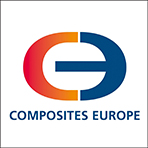
2013 September,
Composites Europe exhibition at Stuttgart
Impressions and reactions at one of the most
highlight exhibitions of composite technology...
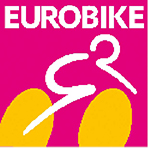
2013 August,
Eurobike exhibition at Friedrichshafen
The first public introduction and reception of the concept at the bike industry Global Show.
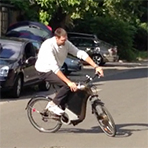
2013 autumn - In the streets...
Pictures of the first tests and street appearances of the bike in and around Budapest...
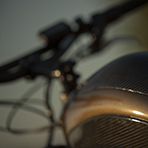
2013 August - Ready to go!
This is a series of professional photographs
of the Spaceframe Concept Bike...
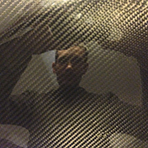
2010-2013: The idea and its progression
Some interesting photographs from
the process of making the concept model...
Development
Prior to developing the concept model a test bike has been prepared from a women's bike, providing a solution for transporting a handbag in the central area. In this case the luggage was held by a loop that was added to the frame. The size range that might be comfortably transported between the knees was specified after trying out various size handbags on the test bike. As a next step, models, drawings and 3D models were made, and the alternatives, the optional electric system and the altering frame types were taken into account at that stage. Finally, we selected the frame to be built as a concept model.
The pedelec e-bike concept model shown here has been prepared with a full carbon fibre frame and with an internal waterproof luggage space that is both large enough for an ordinary bag, and narrow enough to facilitate comfortable riding.
The development happened in various places, along with other activities. In the process of development, the original plans have been modified and rationalized a couple of times, and the concept model has finally been finished after a bit more than two years. A few photos on the process itself can be found in the Gallery section.
Acknowledgements
At this point I would like to say many thanks, first of all to my family members for their patience and support, and also to certain people and companies who helped this concept model project to succeed. Special thanks to Gábor Nádasi, the developer of the Stringbike carbon frame, who helped a lot and most probably saved us months of work that otherwise might easily have been spent on producing crap. Many thanks to the management of Csepel, the oldest Hungarian bike company for accommodating the project. Thanks to e-bike specialists such as György Dreiszinger from Green Scooter; Gábor Hangay, a developer of the Pannon Rider recumbent solar powered e-bike; the Hungarian Association of the Manufacturers of Reinforced Plastic Materials, and some guys at EV-Power who helped me a lot in building the Concept Bike's customized electric system. Thanks to those who have not been mentioned here by name.
inventor
1072 Budapest, Akácfa utca 6 - Hungary